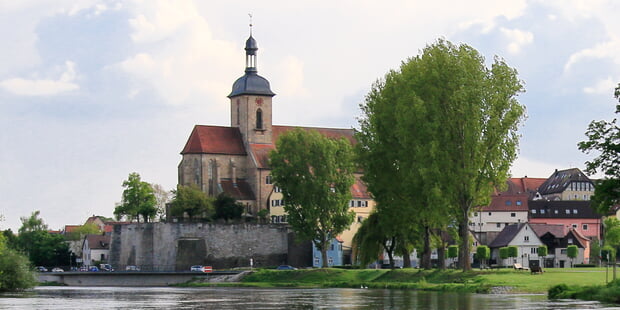
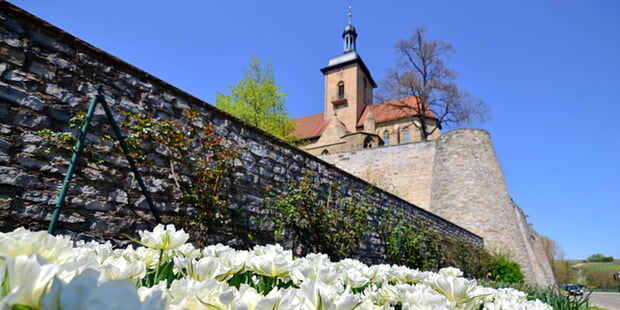
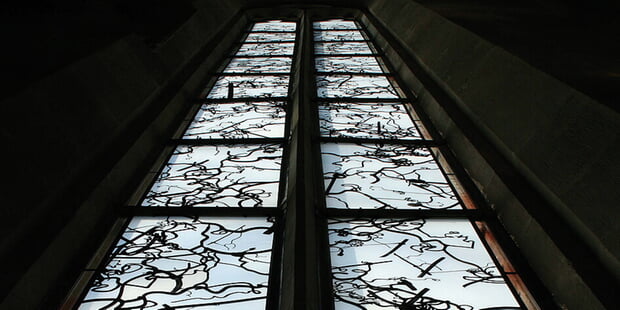
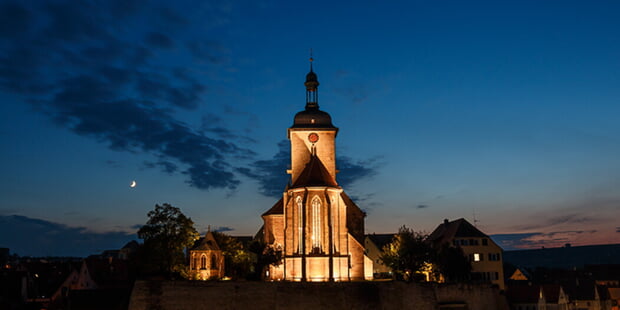
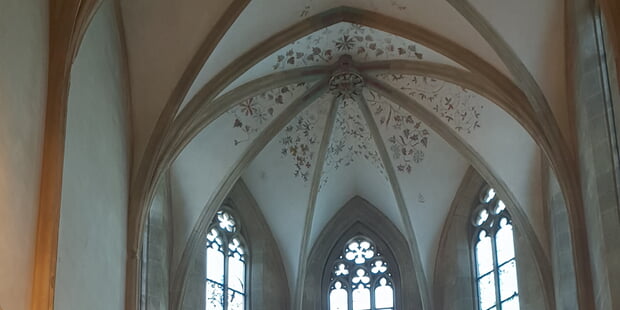
Die Regiswindiskirche wird als Martinskirche in Holzbauweise erstmals 741 /742 erwähnt. Den ersten kleinen Steinbau ließ Bischof Humbert von Würzburg zur Beisetzung der Gebeine der Ortsheiligen Regiswindis errichten. Von 1050 bis 1150 erfolgte der Neubau als mittelromanische Kirche. Von 1227 bis 1300 wurde sie erneut wiederaufgebaut, dieses mal der Heiligen Regiswindis geweiht. Während sie im Mittelalter als Wallfahrtskirche diente, ist sie seit der Reformation evangelische Pfarrkirche. Im Jahr 1564 brannte die Kirche teilweise ab (Chor blieb bestehen). Im Jahr 1567 war die Wiederherstellung schon weit fortgeschritten. Der Chor der Kirche wurde noch im 17. Jh. als Begräbnisstätte für vornehme, vorwiegend geistliche Personen benutzt.
First recorded as Martin’s Church – timber construction - in 741/742. The initial small stone structure was erected by Bishop Humbert of Würzburg for the burial of the remains of the local Saint Regiswindis. New construction as a mid-romanic church between 1050 – 1150. From 1227 – 1300 reconstruction and dedication to Saint Regiswindis. In medieval times it was a pilgrimage church. Since the reformation it has been a Protestant parish church. In 1564 the church was partially destroyed by fire – the sanctuary remained intact. By 1567 the restoration was well advanced. The church sanctuary was still used in the 17th century as a burial place for distinguished people, mainly clergy.
Évoquée la première fois en 741 / 742 sous le terme d’église Saint Martin possédant une construction en bois. L’évêque Humbert de Würzburg fit édifier le premier petit bâtiment en pierre pour y faire reposer les ossements de la Sainte locale Regiswindis. Aménagée entre 1050 et 1150 en église du deuxième âge roman. Entre 1227 et 1300, nouvelle reconstruction consacrée à la Sainte Regiswindis. Au Moyen Âge, lieu de pèlerinage. Depuis la réformation, paroisse évangélique. En 1564 l’église brûla en partie (le choeur resta intact), en 1567 la reconstruction était déjà très avancée. Encore au 17ième siècle, le choeur de l’église servait de sépulture pour les nobles en majorité ecclésiastiques.
- Rathausburg und BurgmuseumCastle and castle museumLe château fort et le musée du château fort
- KriegerdenkmalWar MemorialMonument aux morts de la Première Guerre mondiale
- Gasthof SonneSun InnAuberge du Soleil
- Geburtshaus Robert GradmannBirthplace of Robert GradmannMaison natale de Robert Gradmann
- Stadtmauer beim ehemaligen mittleren TorTown Wall at the former Middle Gate Mur d’enceinte de la ville à l'ancienne porte du milieu
- Altes Heilbronner TorOld Heilbronn GateVieille porte de Heilbronn
- WallTown Fortification Wall Remparts
- VogtshofBailiff’s ResidenceRésidence du bailli
- Altes Gefängnis (Engelhansenturm)Old Prison (Engelhansen Tower)Ancienne Prison (Tour Engelhansen)
- Ehemaliges herrschaftliches Korn- oder Haberhaus Former stately Granary Ancien grenier à grains seigneurial ou « Haberhaus »
- Alte Kelter (Neuer Bau)Old Wine Press (New Building)Vieux pressoir (Nouveau bâtiment)
- MartinskircheSt. Martin’s ChurchÉglise Saint Martin
- Neues Heilbronner TorNew Heilbronn GateNouvelle porte de Heilbronn
- Ehemaliger DrittelhofFormer One-third FarmAncienne « ferme tierce » « Drittelhof »
- Ehemalige GerbereiFormer Tannery Ancienne tannerie
- ErkerhausBay Window House Maison à encorbellement
- Regiswindiskirche (12/1)Regiswindis Church (12/1)L’église « Regiswindis » (12/1)



